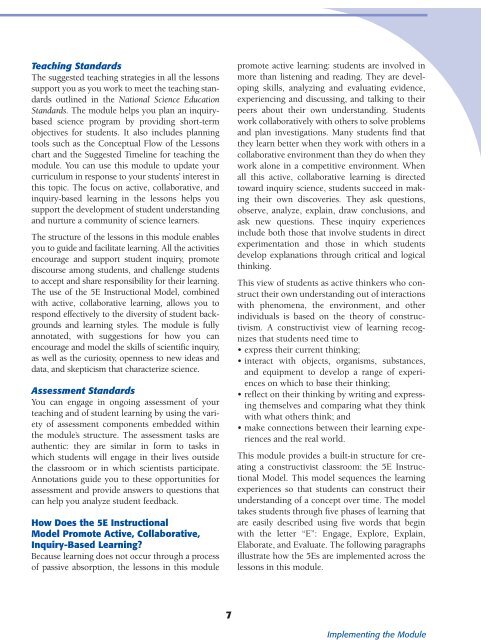Biological - NIH Office of Science Education - National Institutes of ...
Biological - NIH Office of Science Education - National Institutes of ...
Biological - NIH Office of Science Education - National Institutes of ...
Create successful ePaper yourself
Turn your PDF publications into a flip-book with our unique Google optimized e-Paper software.
Teaching Standards<br />
The suggested teaching strategies in all the lessons<br />
support you as you work to meet the teaching standards<br />
outlined in the <strong>National</strong> <strong>Science</strong> <strong>Education</strong><br />
Standards. The module helps you plan an inquirybased<br />
science program by providing short-term<br />
objectives for students. It also includes planning<br />
tools such as the Conceptual Flow <strong>of</strong> the Lessons<br />
chart and the Suggested Timeline for teaching the<br />
module. You can use this module to update your<br />
curriculum in response to your students’ interest in<br />
this topic. The focus on active, collaborative, and<br />
inquiry-based learning in the lessons helps you<br />
support the development <strong>of</strong> student understanding<br />
and nurture a community <strong>of</strong> science learners.<br />
The structure <strong>of</strong> the lessons in this module enables<br />
you to guide and facilitate learning. All the activities<br />
encourage and support student inquiry, promote<br />
discourse among students, and challenge students<br />
to accept and share responsibility for their learning.<br />
The use <strong>of</strong> the 5E Instructional Model, combined<br />
with active, collaborative learning, allows you to<br />
respond effectively to the diversity <strong>of</strong> student backgrounds<br />
and learning styles. The module is fully<br />
annotated, with suggestions for how you can<br />
encourage and model the skills <strong>of</strong> scientific inquiry,<br />
as well as the curiosity, openness to new ideas and<br />
data, and skepticism that characterize science.<br />
Assessment Standards<br />
You can engage in ongoing assessment <strong>of</strong> your<br />
teaching and <strong>of</strong> student learning by using the variety<br />
<strong>of</strong> assessment components embedded within<br />
the module’s structure. The assessment tasks are<br />
authentic: they are similar in form to tasks in<br />
which students will engage in their lives outside<br />
the classroom or in which scientists participate.<br />
Annotations guide you to these opportunities for<br />
assessment and provide answers to questions that<br />
can help you analyze student feedback.<br />
How Does the 5E Instructional<br />
Model Promote Active, Collaborative,<br />
Inquiry-Based Learning?<br />
Because learning does not occur through a process<br />
<strong>of</strong> passive absorption, the lessons in this module<br />
promote active learning: students are involved in<br />
more than listening and reading. They are developing<br />
skills, analyzing and evaluating evidence,<br />
experiencing and discussing, and talking to their<br />
peers about their own understanding. Students<br />
work collaboratively with others to solve problems<br />
and plan investigations. Many students find that<br />
they learn better when they work with others in a<br />
collaborative environment than they do when they<br />
work alone in a competitive environment. When<br />
all this active, collaborative learning is directed<br />
toward inquiry science, students succeed in making<br />
their own discoveries. They ask questions,<br />
observe, analyze, explain, draw conclusions, and<br />
ask new questions. These inquiry experiences<br />
include both those that involve students in direct<br />
experimentation and those in which students<br />
develop explanations through critical and logical<br />
thinking.<br />
This view <strong>of</strong> students as active thinkers who construct<br />
their own understanding out <strong>of</strong> interactions<br />
with phenomena, the environment, and other<br />
individuals is based on the theory <strong>of</strong> constructivism.<br />
A constructivist view <strong>of</strong> learning recognizes<br />
that students need time to<br />
• express their current thinking;<br />
• interact with objects, organisms, substances,<br />
and equipment to develop a range <strong>of</strong> experiences<br />
on which to base their thinking;<br />
• reflect on their thinking by writing and expressing<br />
themselves and comparing what they think<br />
with what others think; and<br />
• make connections between their learning experiences<br />
and the real world.<br />
This module provides a built-in structure for creating<br />
a constructivist classroom: the 5E Instructional<br />
Model. This model sequences the learning<br />
experiences so that students can construct their<br />
understanding <strong>of</strong> a concept over time. The model<br />
takes students through five phases <strong>of</strong> learning that<br />
are easily described using five words that begin<br />
with the letter “E”: Engage, Explore, Explain,<br />
Elaborate, and Evaluate. The following paragraphs<br />
illustrate how the 5Es are implemented across the<br />
lessons in this module.<br />
7<br />
Implementing the Module

















